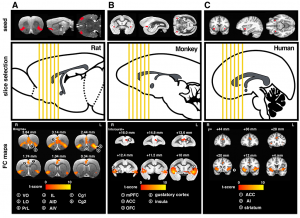 Hot Off the Press – July 17 , 2020.
Hot Off the Press – July 17 , 2020.
The human salience network (SN) detects relevant stimuli to guide behavior and is implicated in neuropsychiatric diseases. In this study, we identified a functionally and structurally connected rat SN sharing spatial similarity with humans. We further demonstrated the functional implications of this network with conditioned heroin withdrawal in rats, wherein the rat SN responses to emotionally salient stimuli and reorganizes attention to internal reference. The study provides a translational platform for mechanistic understanding of neuropsychiatric diseases.
Publication Information
Converging structural and functional evidence for a rat salience network Journal Article
In: Biological Psychiatry, 2020, ISBN: 0006-3223.
